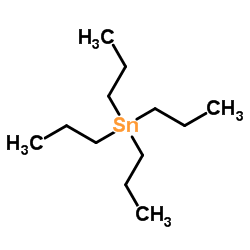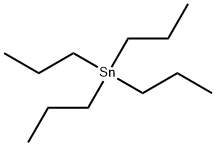四丙基锡 ,Tetra-n-propyltin ,≧98%
产品编号:Bellancom-B293686| CAS NO:2176-98-9| 分子式:C12H28Sn| 分子量:291.0607
本网站销售的所有产品仅用于工业应用或者科学研究等非医疗目的,不可用于人类或动物的临床诊断或者治疗,非药用,非食用,
| 产品名称 | 四丙基锡 |
|---|---|
| 英文名称 | Tetra-n-propyltin |
| CAS编号 | 2176-98-9 |
| 产品熔点 | -109ºC |
| 产品沸点 | 263.2±23.0 °C at 760 mmHg |
| 产品密度 | 1.1 |
| 产品闪点 | 115.3±9.7 °C |
| 精确质量 | 292.121307 |
| LogP | 7.74 |
| 蒸气压 | 0.0±0.5 mmHg at 25°C |
| 折射率 | 1.4745 |
| 稳定性 | 避免氧化物接触,危险分解产品为一氧化碳和二氧化碳 ,有毒的金属氧化物 |
| 储存条件 | 储存的地方必须远离氧化剂,保持容器密封,放入紧密的出藏器内,储存在阴凉,干燥的地方 |
相关文档
化学品安全说明书(MSDS)
下载MSDS质检证书(COA)
相关产品
| 风险声明 (欧洲) | R23/24/25 |
|---|---|
| 安全声明 (欧洲) | 26-27-36/37/39 |
| 危险品运输编码 | UN 2788 |
| 海关编码 | 2931900090 |
|
Section 1: Product Identification Chemical Name:Tetra-n-propyltin, min. 97% CAS Registry Number:2176-98-9 Formula:Sn(C3H7)4 EINECS Number:218-536-0 Chemical Family:organotin compound Synonym:Tin, tetrapropyl-, Tetrapropylstannane
Section 2: Composition and Information on Ingredients IngredientCAS NumberPercentACGIH (TWA)OSHA (PEL) Title Compound2176-98-9100%0.1mg/m30.1mg/m3 Section 3: Hazards Identification Emergency Overview:Irritating to the respiratory tract, skin and eyes. May be harmful if swallowed. Primary Routes of Exposure:Ingestion, inhalation, skin, eyes Eye Contact:Causes severe irritation of the eyes. Causes slight to mild irritation of the skin. Prolonged contact may dry the skin and lead to rashes or more Skin Contact: severe irritation. Inhalation:Irritating to skin, eyes and respiratory tract. Delayed and permanent psycho-neurological disturbances; impairment of vision, unsteadiness, nausea and Ingestion: vomiting. Irritating to skin, eyes and mucous membranes. Ingestion of certain organotin compounds may cause delayed Acute Health Affects: poisoning (4 days) with cerebral edema causing damage to the central nervous system. Repeated exposure to certain organic tin compounds may cause problems with vision, skin, respiratory Chronic Health Affects: system, central nervous system, liver, kidneys, urinary tract, and blood. NTP:No IARC:No OSHA:No SECTION 4: First Aid Measures Immediately flush the eyes with copious amounts of water for at least 10-15 minutes. A victim may need Eye Exposure: assistance in keeping their eye lids open. Get immediate medical attention. Wash the affected area with water. Remove contaminated clothes if necessary. Seek medical assistance if Skin Exposure: irritation persists. Remove the victim to fresh air. Closely monitor the victim for signs of respiratory problems, such as difficulty Inhalation: in breathing, coughing, wheezing, or pain. In such cases seek immediate medical assistance. Seek medical attention immediately. Keep the victim calm. Give the victim water (only if conscious). Induce Ingestion: vomiting only if directed by medical personnel. SECTION 5: Fire Fighting Measures Flash Point:no data Autoignition Temperature:no data Explosion Limits:no data Extinguishing Medium:carbon dioxide, foam or dry powder Fire fighters should be equipped with a NIOSH approved positive pressure self-contained breathing apparatus Special Fire Fighting Procedures: and full protective clothing. Hazardous Combustion andcarbon monoxide, carbon dioxide, soot, organic fumes and tin compounds. Decomposion Products: Unusual Fire or Explosion Hazards: No unusual fire or explosion hazards. SECTION 6: Accidental Release Measures Small spills can be mixed with vermiculite, ground limestone, sodium carbonate or other suitable Spill and Leak Procedures: noncombustible adsorbent and swept up. SECTION 7: Handling and Storage Handling and Storage:Store in a cool, dry, well ventilated area away from heat and direct sunlight. Keep containers tightly sealed. SECTION 8: Exposure Controls and Personal Protection Eye Protection:Always wear approved safety glasses when handling a chemical substance in the laboratory. Skin Protection:Wear protective clothing and gloves. Consult with glove manufacturer to determine the proper type of glove. Ventilation:Work with this product in a well-ventilated area, preferably a fume hood. If ventilation is not available a respirator should be worn. The use of respirators requires a Respirator Respirator: Protection Program to be in compliance with 29 CFR 1910.134. Ventilation:Work with this product in a well-ventilated area, preferably a fume hood. Additional Protection:No additional protection required. SECTION 9: Physical and Chemical Properties Color and Form:colorless liq. Molecular Weight:291.05 Melting Point:no data Boiling Point:222°C Vapor Pressure:no data Specific Gravity:1.1065(20°) Odor:not determined Solubility in Water:insoluble SECTION 10: Stability and Reactivity Stability:air and moisture stable Hazardous Polymerization:no hazardous polymerization Conditions to Avoid:none Incompatibility:strong oxidizing agents and halogens Decomposition Products:carbon monoxide, carbon dioxide, tin oxide, and organic fumes. SECTION 11: Toxicological Information RTECS Data:Parenteral (mouse); LDLo: 73 mg/kg. Carcinogenic Effects:No data available Mutagenic Effects:No data available Tetratogenic Effects:No data available SECTION 12: Ecological Information Ecological Information:No information available SECTION 13: Disposal Considerations Disposal:Dispose of according to federal, state, and local regulations. SECTION 14: Transportation Shipping Name (CFR):Non-hazardous Hazard Class (CFR):NA Additional Hazard Class (CFR):NA Packaging Group (CFR):NA UN ID Number (CFR):NA Shipping Name (IATA):Non-hazardous Hazard Class (IATA):NA Additional Hazard Class (IATA):NA Packaging Group (IATA):NA UN ID Number (IATA):NA SECTION 15: Regulatory Information TSCA:Not listed in the TSCA inventory. SARA (Title 313):Title compound not listed. Second Ingredient:none SECTION 16 - ADDITIONAL INFORMATION N/A |










 浙公网安备 33010802013016号
浙公网安备 33010802013016号